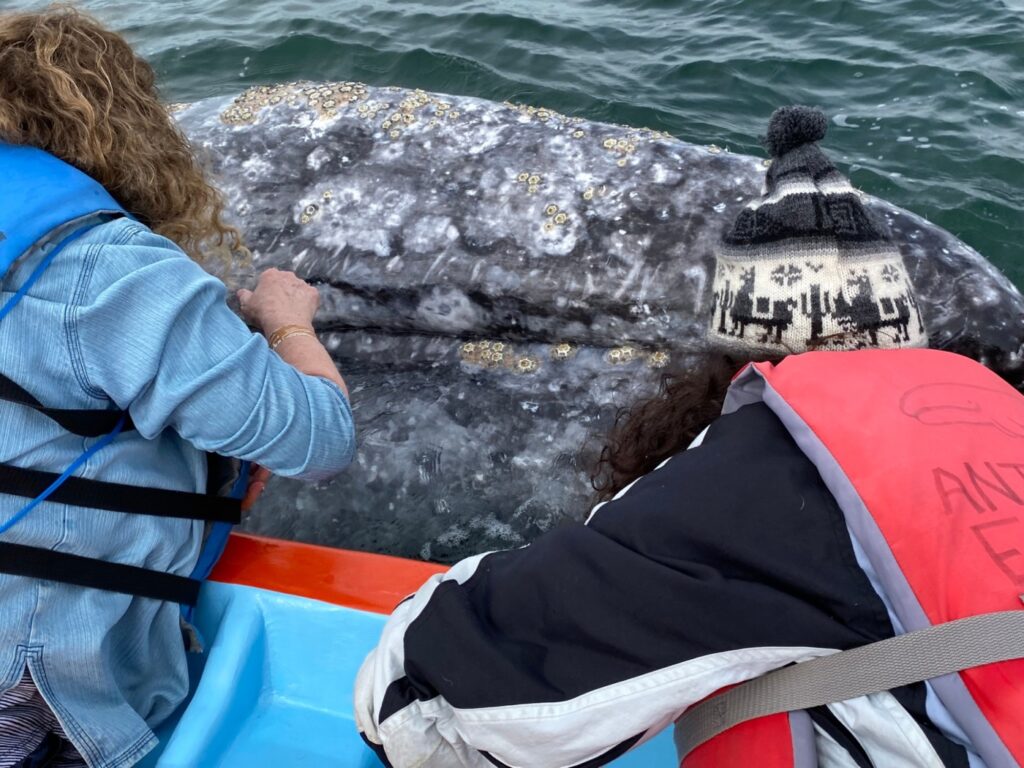
You may be surprised to learn that I just petted a whale. That’s right, I said whale, not dog or cat or gerbil. Whales generally live in the ocean and are quite hard to get close to, so it requires a somewhat involved journey to go to the one place on the planet where you can actually get close enough to do this.
If you live in California, you probably know that gray whales migrate each winter from their home near Alaska to lagoons in Baja California, where they generally party like spring breakers. That’s right. They’re vacationing, having sex, socializing and — a year later —coming back to have their babies. Even though the lagoons seem cold to us, they’re practically tropical to the whales, who are used to swimming near the Arctic Circle.
Some of you have taken trips out into the Pacific Ocean to watch the whale migration, which occurs each year from December to the end of April. This can be interesting, although the whales are on the move, hustling to get to Mexico where the beer is cheaper so they aren’t interested in hanging around and letting you pet them, no matter how many treats you offer. On the way north, they’re hustling to get back up to Alaska, where they eat plankton and generally enjoy being home again, even though it’s insanely cold up there. This is why they have so much blubber, to stay warm. (That’s also my excuse.)
If you are a whale-maniac like me, then you probably want to head down to one of the three lagoons the whales frequent when they get to Baja California, where you will definitely be able to see them cavorting with each other and possibly even have a friendly encounter. Trust me, this is life-changing. No one ever forgets their whale experience in Baja.
The three lagoons are: Scammon’s Lagoon (also known as Ojo de Liebre), San Ignacio lagoon and Magdalena Bay, running from north to south. I’ve been to all these lagoons numerous times because (see above) I’m a fanatical whale lover. It’s somewhat miraculous that the whales still come here, considering they were nearly hunted to extinction by whalers at one time, once they discovered that the whales were pretty much sitting ducks (just to mix metaphors here) in the lagoons and could easily be harpooned. In those days, people used whale oil for lamps and various other things, so they were a valuable commodity.
Fortunately, Mexico bans whaling, so the population has rebounded nicely. And no one’s going into the lagoons to try to kill whales and their newborn calves. However, people are going into the lagoons to try to see them, which is a good thing, because it provides an incentive for the Mexican government to protect them even more.
The lagoon that’s most famous for its friendly whales is near the sleepy oasis town of San Ignacio, which is halfway down the Baja peninsula. There’s no commercial airport nearby, so it means you have to drive for hours — sometimes many hours — to get there. But that doesn’t stop people like me, who keep coming down anyway, because the prospect of being near these behemoths and actually touching or even kissing them is worth the effort.
Some 40 years ago, or so the story goes, a local fisherman named Pachico Mayoral was initially frightened — then fascinated — when a whale kept coming up to his small boat to greet him. His friends and family demanded he take them out into the lagoon to see this. Those first encounters ended up launching an entire tourism industry now strictly regulated by the Mexican government to make sure the whales are protected.
Only a portion of the lagoon is open to tour boats, while most of it is off limits. This means that the only whales you see on the tour are ones who are choosing to be there, and choosing to come up to your boat and greet you. This is such a remarkable experience, to have these huge animals come over to say “hi,” that you really can’t help screaming and sometimes even crying when it happens.
This ain’t SeaWorld, people. It’s real. Wild marine animals that want to be your friend.
Last week, my friends and I flew into the small, charming Baja resort town of Loreto, rented a car, and then drove five hours across the peninsula to San Ignacio, where we hired a boat to take us out into the remote lagoon, which is reachable only by a rough road that’s partly dirt.
There was lots of screaming and crying coming from our boat, as the whales came up to visit. These huge creatures could easily swamp the small fiberglass boat if they chose, but they don’t. We even got covered with whale spit when they exhaled near us. I know, it wasn’t really spit, don’t send me any letters about it.
“But, Marla,” you’re saying to me. “You’re sick and gimpy. How could you do that?” Well, it’s not as hard as you might think. Wheelchair in the airport, sitting in a comfy rental car and then a van to the lagoon. There were lots of friendly guys to haul my sorry butt into the boat. There was even a wheelchair-friendly disabled outhouse.
So if you want to do this, just go. Don’t let anything stop you. No, we didn’t catch COVID. No, we weren’t attacked by bandidos. We weren’t even chased by roving mariachis. If you want me to talk more about this subject next week, shoot me an email at mfisher@scng.com. Otherwise, thanks for reading and join my Facebook page. We have fun on there.
Related links
Frumpy Middle-aged Mom: So here’s what happened in Baja
Whale-watching in Baja California
Mom gone wild
San Javier: Bygone Baja
A budget family safari in Kenya
